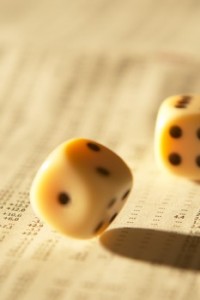Gambling Math Basics
Gambling can be a lot of fun even if you don’t understand any of the math behind it, but it’s even more fun if you have a fundamental understanding of how probability and odds work. The purpose of this page is to provide an introduction to how probability works and how odds work. Those are the gambling math basics.
[showSites]
What Is Probability?
 Probability refers to the chance that a certain outcome will happen in a given situation. It can be expressed as a fraction, as a percentage, or as odds. All probabilities are numeric values, and they’re always a number between 0 and 1.
Probability refers to the chance that a certain outcome will happen in a given situation. It can be expressed as a fraction, as a percentage, or as odds. All probabilities are numeric values, and they’re always a number between 0 and 1.
Something with a probability of 0 is something that could never possibly happen. By definition, a probability of 0 is an outcome that is impossible. For example, if you roll a six-sided die that’s numbered 1 through 6, the probability of rolling a 7 is 0.
Something with a probability of 1 is a certainty. It will always happen. For example, if you roll a six-sided die that’s numbered 1 through 6, the probability of rolling a 1, 2, 3, 4, 5, or 6 is 1.
You’re probably most used to seeing a probability expressed as a percentage. In that first example, the probability of rolling a 7 was 0%. In the second example, the probability of rolling a number between 1 and 6 was 100%.
The probability of an outcome is easily calculated. You take the total number of ways achieving the outcome, and you divide it by all of the possible outcomes.
For example, if you want to calculate the probability of flipping a coin and having it land on heads, you look at the total number of ways it could land on heads. On a normal coin, that’s one. You divide that one by the total number of possible outcomes, which is two (heads is one possibility; tails is the other–so that’s two possible outcomes.)
So the probability of getting heads is 1/2, or 50%. You could even express this probability as a decimal, in which case it would be 0.5.
What Are Odds?
Odds are just another way of expressing a probability. When you express a probability as odds, you have the number of ways that the outcome doesn’t happen compared to the number of ways the outcome can happen.
For example, when flipping a coin, the odds of getting head are 1 to 1, or even odds. If you’re rolling a six-sided die, and you want to know the odds of getting a 1, you have 5 ways of NOT getting the 1, and a single way of getting the 1, so the odds are 5 to 1. (You could express that as 1/6 as a fraction, as 0.1667, or as 16.67%.)
Why Do Odds and Probability Matter When You’re Gambling
Bets pay off at certain odds, too. And when a bet pays off at the same odds as the probability of winning the bet, you have an even money situation. You’ll win exactly half the time, and the other side will win half the time.
For example, if you bet $1 to win $1 on a coin flip, then you’re making an even odds bet. The outcome also offers even odds. So over time, you’ll probably break even.
But suppose you bet $1 for the coin to land on heads, but if you win, you get $2. Over time, you’d win a significant amount of money, because half the time you’d win $2, but the half the time that you lose, you’d only lose $1.
You’d have to find a real idiot to offer you those kinds of odds. (Luckily, those kinds of idiots play poker all the time. The odds are a little more complicated to figure out in poker, so inferior players will often give you better odds on your bet than you deserve, and that’s why there’s such a thing as a professional poker player.)
The casino’s profits come from the difference between the odds that they pay out on a bet and the odds of your actually winning the bet.
The easiest example to think of is a simple even money bet on black at the roulette table. If you bet $5 on black, you’ll win $5 if the ball lands on black. You’ll lose $5 if the ball lands on red. But you’ll ALSO lose $5 if the ball lands on one of the green zeros.
There are 38 possible results on an American roulette wheel. 18 of them are black. That means the probability of winning a bet on black are 18/38, or 47.37%. So the casino will win slightly more than half the time. That’s how they make their profit.
The odds of winning a bet on black are 20 to 18, which means there are 20 ways to lose, and 18 ways to win. That can be reduced to 10 to 9, just like a fraction.
The bigger the difference between the odds of winning and the odds that are paid out, the greater the casino’s house edge is.
